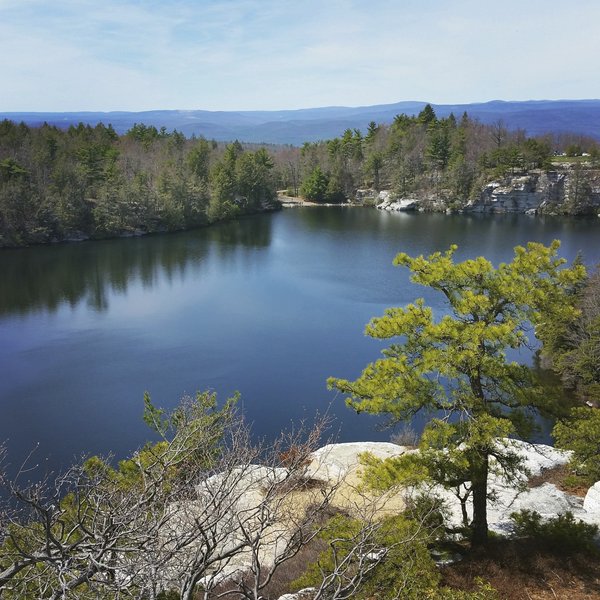
Minnewaska State Park (photo via @nystateparks)
Most New Yorkers take their drinking water for granted. We think of contaminated drinking water as a problem that happens to other people in other parts of the world. However, the recent crises in Flint, Michigan and Hoosick Falls, New York forced us to realize that these problems can also crop up close to home. As we continue to celebrate Earth Day, let us take a few minutes to reflect on the current situation and consider some of the threats to our drinking water right here at home, as well as what we can do about them.
Flint has become the poster child for the kind of devastation drinking water contamination can wreak on a community. Thousands of children in Flint have been exposed to dangerous levels of lead, and their water is still not safe to drink. This problem is not just happening in Flint, but also Binghamton, New York and likely many more communities across the country that still have lead pipes in place.
Since the time of Roman aqueducts, water infrastructure has been a hallmark of advanced civilization. Yet we have let our public drinking water systems crumble in neglect. The Environmental Protection Agency (EPA) now estimates that communities face a $384 billion backlog to repair drinking water infrastructure across the country.
Unfortunately, there are also many other threats to consider. While our aging infrastructure has been getting the most attention recently, there are many other dangers to our drinking water, which range from toxic chemicals to Superfund sites to factory farms.
While Flint may well be the worst example, it is not the only time reckless disregard for our drinking water has had lasting impacts on public health. In late 2015, the EPA urged residents of Hoosick Falls, a village of 3,500 people about 30 miles northeast of the State Capitol in Albany, not to drink or cook with the tap water. This is because testing of the village's water detected levels of the chemical PFOA that made the water unfit for human consumption. This toxic chemical has been linked to an increased risk for cancer, thyroid disease, and serious complications during pregnancy.
A federal class-action lawsuit has been filed against Saint-Goblin Performance Plastics and Honeywell International, which both operated manufacturing plants that are a focus of the contamination. The toxic chemical is associated with the making of Teflon, which was used in products manufactured at the plants.
Across the nation, concern over various types of water contamination has risen. In recent years, officials have documented more than 1,000 cases of oil and gas drilling operations contaminating local water. Agricultural pollution is threatening drinking water in places like Ohio, where runoff from agribusiness operations contributed to a toxic algae bloom in Lake Erie, which contaminated the drinking water for 500,000 people around Toledo with cyanotoxins in 2014.
We believe all New Yorkers deserve safe drinking water. We know what it will take to achieve this vision.
First, we need to restore the public infrastructure that brings water to our taps. Second, as the incident in Hoosick Falls shows, we also must protect the rivers, streams, and aquifers from which we draw our water. And finally, the public must have the right to know about water pollution – with robust monitoring of our waterways, regular testing from our taps, and standards that truly protect public health.
On each of these fronts, we are making progress, but much more work lies ahead. The crisis unfolding in Flint has finally put water infrastructure on Congress’ radar. In addition to ongoing negotiations to immediately aid Flint itself, New York Rep. Paul Tonko has now introduced bills to triple funding of the safe drinking water state revolving fund. In the past, the program has enjoyed broad bipartisan support. Congress must overcome the current mood of partisan rancor and give communities the resources they need to get the lead out.
For protecting our sources of drinking water, EPA took a landmark step last year in restoring protections of the Clean Water Act to streams, which help provide drinking water to 117 million Americans, including 11 million in New York. But these protections are currently tied up in the courts, while also facing another round of attacks from polluters and their allies in Congress this spring, so we’ll need our representatives to stand up and continue to fight for clean water protections.
We are also seeing small steps to enhance our right to know when our water is at risk. Just two months ago, the House overwhelmingly passed a bipartisan bill to strengthen EPA’s duty to notify the public when lead is putting drinking water at risk. Other proposals are being considered to require testing for lead in both drinking water and in children’s blood levels.
To build on this progress it will take political will. So on this Earth Day, let us vow to keep drinking water on the forefront of our minds even long after stories of Flint have left the front pages of our papers.
***
Heather Leibowitz, Esq. is the Director of Environment New York, a statewide environmental advocacy group. On Twitter @EnvNY.
***
Have an op-ed idea or submission for Gotham Gazette? Email This email address is being protected from spambots. You need JavaScript enabled to view it.




